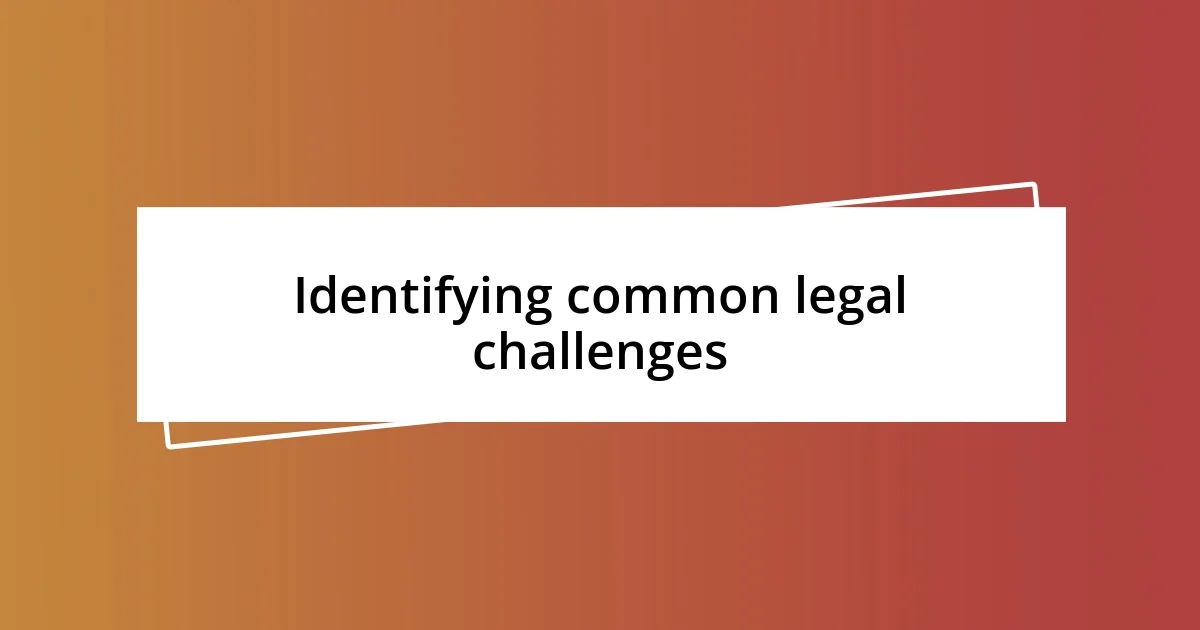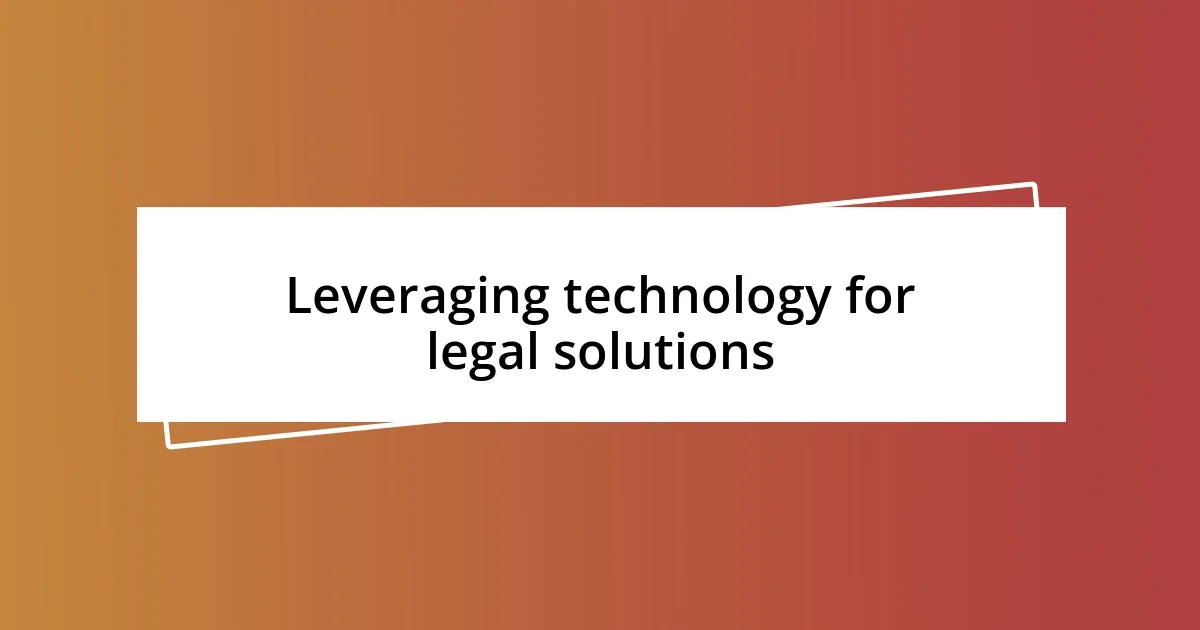Key takeaways:
- Understanding local laws and cultural nuances is crucial for successfully navigating cross-border legal issues and avoiding penalties.
- Collaborating with local legal experts can provide valuable insights and expedite processes, transforming the approach to legal challenges.
- Leveraging technology, such as AI-driven compliance tools and cloud-based management systems, enhances efficiency and communication in cross-border operations.

Understanding cross-border legal issues
Navigating cross-border legal issues can feel like peeling back layers of an onion—there’s always more to uncover. I remember a time when I was suddenly thrust into a complex international dispute, and I quickly realized that understanding the laws of multiple jurisdictions was not just important; it was crucial for finding a resolution. Have you ever paused to consider how different countries interpret contracts? It’s not just about differing laws; cultural nuances can play a significant role too.
One of the most surprising aspects I learned is how varying legal systems approach concepts like liability and enforcement. For instance, in some jurisdictions, a handshake might carry more weight than a written agreement. This revelation struck me hard during a negotiation with a foreign partner when I naively assumed our written contract would fully protect my interests. What I found, instead, was that trust and reputation often trumped paperwork in those discussions.
The emotional toll of dealing with cross-border legal challenges can be overwhelming. I vividly recall feeling stressed and isolated, trying to navigate through a labyrinth of languages and legal jargon. Have you ever felt like you were in over your head? It’s essential to recognize that seeking help from local experts wasn’t just beneficial; it was a game changer for my case. Understanding the nuances in legal practices across borders not only assured me but ultimately guided me to a path of resolution I hadn’t initially considered.

Identifying common legal challenges
Identifying common legal challenges can be quite the eye-opener for anyone involved in cross-border situations. I recall a specific instance where I faced unexpected regulatory compliance issues when expanding into a new market. At that moment, I realized how vital it is to understand local laws and regulations—what’s acceptable in one country could lead to significant penalties in another. Have you ever found yourself on the wrong side of a regulation? I did, and it reinforced how critical thorough research is.
Another common challenge revolves around the enforcement of legal agreements. I remember drafting a contract that I thought was comprehensive, only to discover that enforcing it in a foreign jurisdiction required navigating a completely different set of rules. It felt daunting, almost like trying to learn a new language overnight. Have you experienced similar frustrations? I’ve learned that directly consulting with local legal experts can significantly alleviate that pressure, as they provide invaluable insights into what might be enforceable or not.
Intellectual property rights also pose a considerable challenge in the cross-border landscape. I was once in a situation where my company’s trademark was at risk because it was registered in one country but not in another where we were operating. This taught me just how easily intellectual property can slip through the cracks when stepping across borders. Sharing these vulnerabilities with colleagues has opened up discussions that highlight the importance of proactive measures in safeguarding ideas and assets in different jurisdictions.
| Legal Challenge | Description |
|---|---|
| Regulatory Compliance | Understanding and adhering to local laws and regulations can vary significantly, leading to possible penalties. |
| Enforcement of Agreements | Different jurisdictions may enforce contracts differently, impacting reliability and trust during negotiations. |
| Intellectual Property Rights | Safeguarding trademarks or patents requires awareness of local registration requirements to prevent infringement. |

Navigating legal frameworks effectively
Navigating legal frameworks effectively is all about understanding the unique legal landscapes of each country involved. I once participated in a joint venture that intertwined our operations in three different countries. Each one had its own labyrinth of regulations, and it felt like a high-stakes game of chess—every move had to be calculated and informed by the rules of each jurisdiction. I can’t stress enough the importance of building a solid foundation of knowledge; having a grasp on foundational legal principles made it possible to anticipate potential pitfalls before they became crises.
Here are some key strategies that I found invaluable:
- Research Local Laws: Invest time in understanding specific laws and regulations in each jurisdiction to avoid costly mistakes.
- Build Relationships with Local Experts: Strong alliances with local legal professionals can provide insights that are critical to navigating the complexities of each legal system.
- Regularly Update Knowledge: Laws change, and staying informed about legal developments can protect you from becoming outdated or non-compliant.
- Leverage Technology: Use legal tech tools to manage compliance and contract terms across different jurisdictions efficiently.
In my journey, I learned that communication is key. I vividly recall a meeting during which I had to resolve a misunderstanding caused by a legal term that had a different connotation in another culture. The apprehension I felt in that moment still resonates with me; I realized the importance of not just translating words, but also translating intent and context. This experience taught me that being proactive in questioning assumptions can lead to a much clearer path through the dense fog of cross-border legal frameworks.

Collaborating with local legal experts
Collaborating with local legal experts has been a game-changer in my approach to managing cross-border challenges. I remember my first major hurdle in a foreign market; I thought I had done my homework, but it wasn’t enough. Local attorneys provided insights that went beyond mere regulations—they offered a cultural perspective that shaped our strategy. Would I have realized the unwritten rules without their guidance? Probably not.
Establishing a partnership with local legal experts isn’t just about expertise; it’s about building trust. During one project, I struggled to understand the nuances of local dispute resolution processes. Engaging a local attorney who specialized in this area was like switching on a light in a dark room. I learned how their relationships with local authorities could expedite processes that would have taken me weeks to navigate alone. Have you ever felt the weight of uncertainty lifting when you have the right people in your corner? That sense of relief is invaluable.
Ultimately, collaborating with local experts is an ongoing relationship. I had an instance where I needed to revisit a previous contract due to new regulations. I reached out to my local counsel, who not only flagged the necessary changes but also highlighted emerging trends that could impact our operations. Their proactive approach saved us time and potential legal setbacks. It’s a reminder that in the ever-evolving legal landscape, having local insights is not just beneficial; it’s essential.

Utilizing international treaties and agreements
Utilizing international treaties and agreements can be a powerful strategy when facing cross-border legal challenges. I recall a particular instance where we encountered a significant hurdle with an export-import issue, entangled in the red tape of two countries’ conflicting regulations. Turning to the World Trade Organization (WTO) agreements, I was able to find provisions that not only aided our situation but also offered a clear framework for resolving the conflict. Isn’t it fascinating how these treaties can serve as guiding lights in otherwise murky waters?
I found that understanding the intricacies of these international agreements involved more than memorizing rules; it required interpretation through the lens of my specific circumstances. During a project involving collaboration with a partner across borders, we referenced the North American Free Trade Agreement (NAFTA). That morning, as I reviewed the treaty’s tariff reductions, I felt a surge of confidence. Not only did it streamline our negotiation process, but it also revealed potential cost-saving measures that we hadn’t considered. Have you ever experienced that “aha” moment when you connect the dots between written regulations and real-world applications? It’s invigorating.
Relying on international treaties helped mitigate risks on multiple occasions. For instance, when disputes arose over contractual issues, I utilized the United Nations Convention on Contracts for the International Sale of Goods (CISG). By invoking its principles, we found ourselves on common ground, avoiding lengthy litigation. In that moment, I was reminded of how pivotal these agreements can be in protecting businesses from pitfalls. They serve not only as a legal framework but also as a valuable resource that can empower us to navigate differences effectively.

Implementing risk management strategies
Implementing risk management strategies requires a proactive mindset and a deep understanding of the legal landscape. I once faced a daunting situation where our operations were threatened by unexpected regulatory changes in a foreign market. By conducting a thorough risk assessment and identifying potential legal pitfalls, my team and I were able to develop a contingency plan that ultimately saved us from costly delays. Have you ever experienced that rush of clarity when you focus on what could go wrong before it happens?
Another key aspect involves regular monitoring and adapting to changing conditions. During a project launch, I realized that new laws were emerging almost monthly. By keeping abreast of these developments, I could swiftly adjust our compliance strategies. It felt empowering to act immediately rather than react, reinforcing the idea that being prepared is half the battle. Doesn’t it give you peace of mind to know you’re not just waiting for issues to arise, but actively keeping them at bay?
Finally, leveraging technology for risk management has made a significant difference in my approach. I integrated a compliance tracking system that helped highlight any deviations from legal requirements in real-time. The satisfaction of knowing I had a digital safety net allowed me to focus more on strategic initiatives rather than getting bogged down by immediate concerns. Have you thought about how technology can be your ally in navigating legal complexities? Embracing these tools can turn a daunting task into a manageable one.

Leveraging technology for legal solutions
In my experience, leveraging technology for legal solutions can transform how we approach cross-border challenges. I remember when I utilized a cloud-based contract management system that allowed us to collaborate seamlessly with international partners. The ability to track changes and access documents simultaneously not only streamlined our workflow but also reduced the risk of miscommunication. Have you ever felt the relief that comes from knowing everyone is on the same page, no matter where they are in the world?
One of the standout moments for me was when my team adopted an AI-powered compliance tool. This smart software scanned vast amounts of regulatory data, pinpointing relevant changes across multiple jurisdictions. It felt like having a legal assistant who could sift through pages of regulations in seconds! The time we saved meant we could focus on strategic decisions rather than getting lost in paperwork. Can you imagine how much more effective we can be when technology takes care of the nitty-gritty, leaving us with the big picture?
During a critical negotiation, I turned to virtual communication platforms that facilitated real-time discussions with international stakeholders. The instant feedback we received helped us to pivot our strategy quickly, which is crucial in a dynamic legal environment. I felt a sense of empowerment knowing that technology was enhancing our capability to engage effectively across borders. Isn’t it amazing how these tools can elevate our legal strategies, turning potential obstacles into mere speed bumps?














